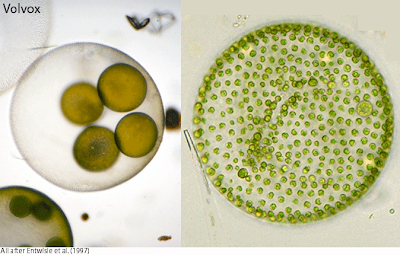Algae - Sexy AND Useful

I was asked recently (thanks Chris Cargill) about whether I posted much about algae on Talkingplants. A little, I said, but I probably overcompensate my obscure interest in these tiny critters by talking more about the big showy flowering things.
Of course most algae aren't really plants. Many of the green ones are closely related to the 'land plants' - flowers, ferns, mosses the like - but the rest are all over the Tree of Life.
Generally the term 'botany' allows algae in, and botanic gardens around the world employ algal and fungal experts (fungi are more closely related to you and I than to plants).
But back to algae! There have been a couple of fascinating discoveries of late. The first is about the sex lives of green algae, the algal group very close to plants in an evolutionary sense. Algae have all sorts of different ways of having sex and that's partly why we don't consider many of them to be plants.
Flowering plants have one way of doing it. It does involve a fancy 'double fertilisation' system, which I won't go into here, but basically we are looking a sperm and egg model with really only one significant life stage - the plant.
Algae do it lots of different ways. There can be three different life stages with various kinds of reproductives structures and sex cells. Sometimes alternative phases can look exactly the same, other times one is tiny and insignificant. They can have obvious male and female bits, or bits that are exactly the same. In fact if you can dream up a sexual life cycle, it's probably already happening in algae.
Two green algae (Volvox and Chlamydomonas) split from a common ancestor 200 million years ago but the first has eggs and sperm, the in the second sex cells are almost identical in size and shape. This means that sex, as we know it (with obviously different bits) may have its origins way back then, with this split in green algae. A small set of genes were found to be in the male Volvox only, and some in the female only.
The same genes were present in the Chlamydomonas but not in the right place - outside what is romantically called the 'mating locus', where sex cells are produced. It's early days for this research but algae may be the place to find out how sex cells evolved, leading to big showy flowering plants and to us.
This research was published recently in the journal Science and there have been some nice online summaries.
If their sex life doesn't excite you, what about that fact that a rise in ocean temperatures of only 2 degrees C would stop some algae producing a gas called Dimethyl Sulphide, or DMS? Who cares you might say, or what's DMS?
Well we should all care because DMS helps clouds to form. When algae in corals produce DMS they help form clouds that block sunlight and cool the sea. Or so our very own Ozzies Graham Jones and his colleagues from Southern Cross University in Lismore found. The research is reported in the journal Environmental Chemistry and has been summarised by New Scientist.
Jones is quoted by New Scientist as saying "It is not a coincidence that much of Australia's rainforest lies adjacent to the northernmost reefs". Less DMS over coral reefs could lead to the drying out of Queensland rainforests, and that's not a good thing.
So algae are sexy, and useful too. And this is just based on a couple of stories from the last month or so...
Image: This is the sexy Volvox, from my algpic site. It's filed under 'soft or firm colonies'.
Image: This is the sexy Volvox, from my algpic site. It's filed under 'soft or firm colonies'.
Comments